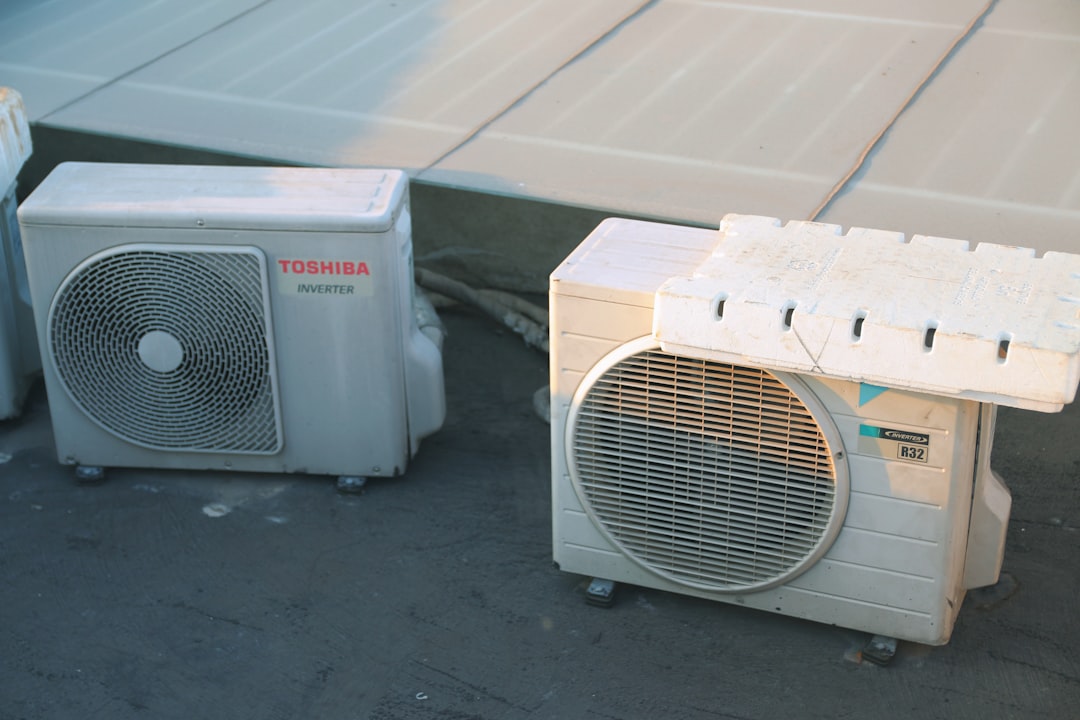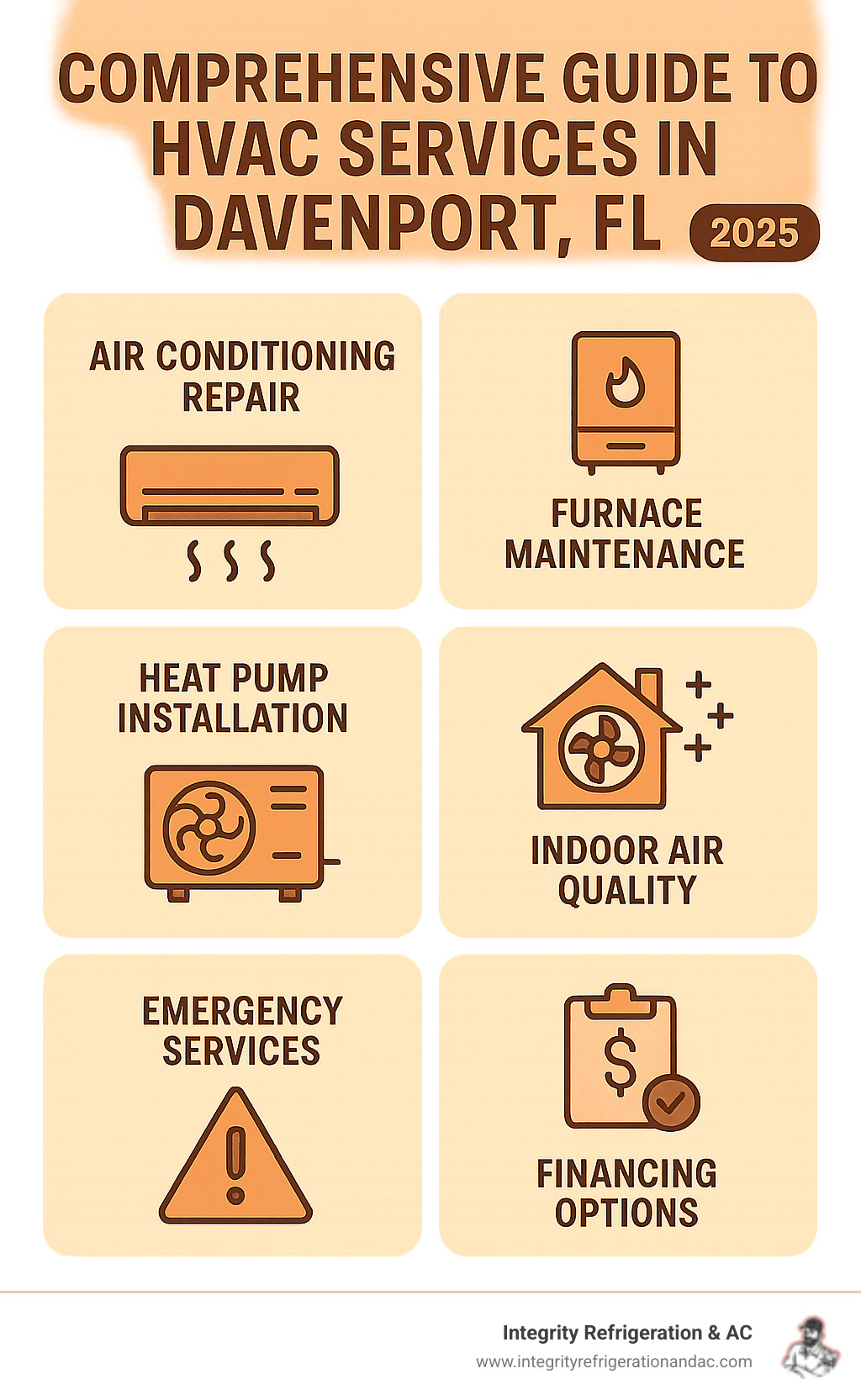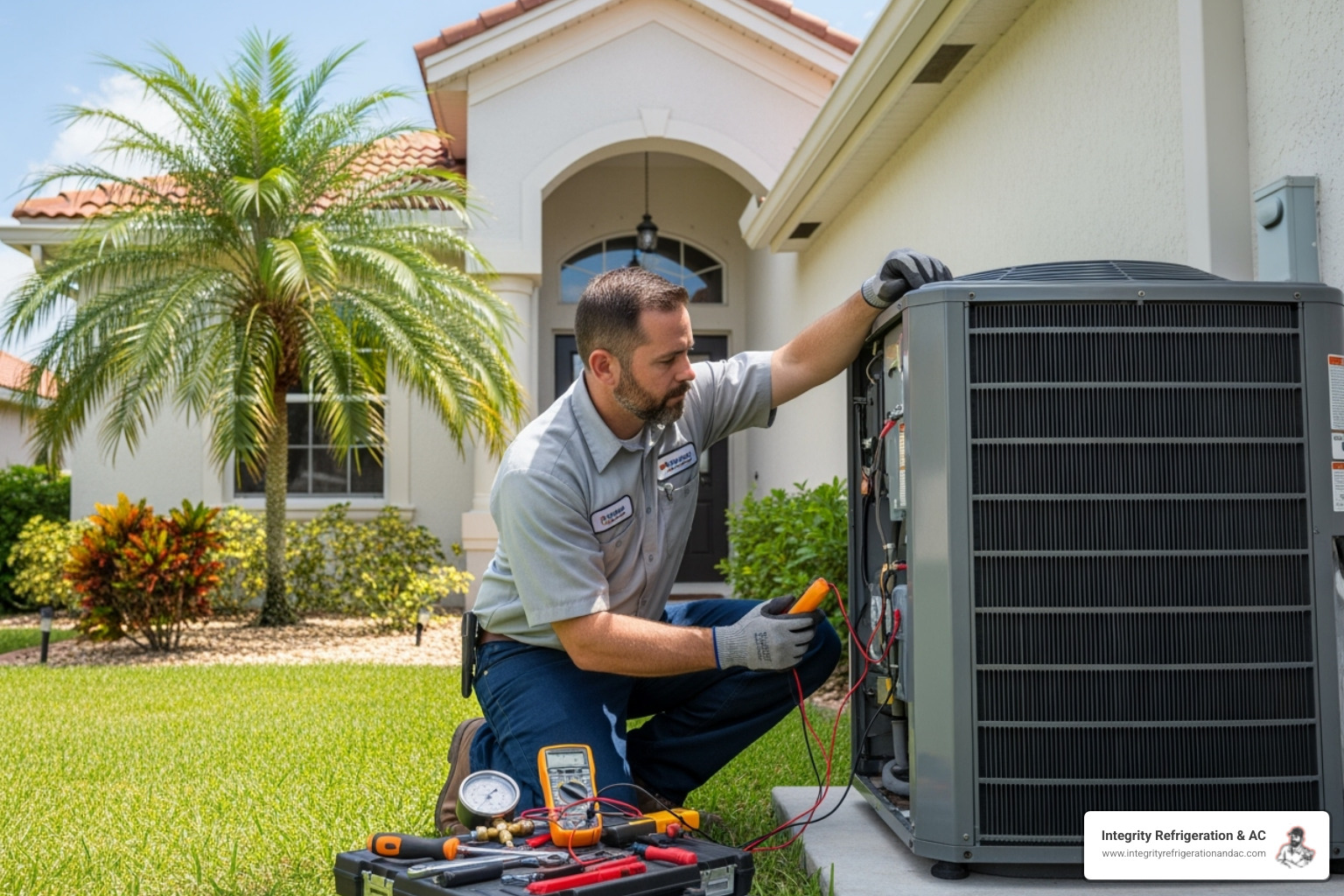Explore Our Latest Insights

Beginner's Guide to Ductless AC Service

Finding Your Perfect Match: Experienced AC Installers in Winter Haven




When you need heating and cooling Davenport services, you're looking for reliable professionals who understand Florida's unique climate challenges. Here's what you need to know:
Top HVAC Services in Davenport:
Living in central Florida means your HVAC system works overtime. With temperatures sometimes rising above 100 degrees in summer and occasional cold spells in winter, your heating and cooling system needs professional care to keep running efficiently.
Modern HVAC systems are much safer and less expensive to run than older models, but they also require more specialized care. Regular maintenance can help you avoid costly breakdowns and keep your energy bills manageable.
Whether you're dealing with an emergency repair, planning a system replacement, or just need routine maintenance, choosing the right local contractor makes all the difference. The best HVAC companies in Davenport offer transparent pricing, flexible financing options, and the expertise to handle all major brands and system types.

When Florida's weather throws you a curveball – whether it's a scorching summer day or an unexpectedly chilly winter morning – you need heating and cooling Davenport services you can count on. At Integrity Refrigeration & AC, we understand that your home's comfort system isn't just about keeping the temperature right. It's about creating a space where your family can relax, breathe easy, and feel truly at home.
We've built our reputation on providing comprehensive HVAC solutions that cover every aspect of home comfort. From system installations that give you a fresh start with energy-efficient equipment, to system repairs that get you back up and running fast, we handle it all. Whether you're dealing with system replacements after years of faithful service or need expert care for all major system types, our team has the experience to deliver results that last.

What sets us apart is our commitment to treating every home like it's our own. Our certified technicians don't just fix problems – they take the time to explain what's happening with your system and help you make informed decisions about your home's comfort. We work with traditional central air systems, modern heat pumps, efficient furnaces, and innovative ductless solutions, ensuring we can meet your specific needs and budget.
Ready to learn more about our complete HVAC solutions? Visit our Heating Cooling Services Davenport FL page for detailed information.
Let's be honest – in Florida, your air conditioner is basically a family member. It works harder than anyone else in the house, running day and night to keep you comfortable through those sweltering summer months. That's why we treat AC repair like the emergency it often is, especially when temperatures soar.
When your AC starts acting up, our technicians spring into action. We've seen it all: systems that suddenly stop cooling, units making strange noises, and thermostats that seem to have a mind of their own. Our approach is straightforward – we diagnose the problem quickly, explain what's wrong in plain English, and get your system back to keeping you cool as fast as possible.
Planning ahead with AC installation is one of the smartest moves Florida homeowners can make. Today's air conditioning systems are light-years ahead of older models in terms of efficiency and reliability. We help you choose the right size and type for your home, considering everything from your family's comfort preferences to your monthly budget goals.
Don't wait for problems to find you – our AC maintenance programs are designed to catch small issues before they become big headaches. Regular tune-ups keep your system running smoothly, help prevent unexpected breakdowns, and can significantly extend your AC's lifespan. Think of it as an insurance policy for your comfort.
Sometimes the most cost-effective solution is AC replacement. If your system is constantly breaking down, driving up your electric bills, or simply can't keep up with Florida's heat anymore, a new unit might save you money in the long run. We provide honest assessments to help you make the best decision for your situation.
For homes that need flexible cooling solutions, ductless mini-splits offer incredible efficiency and convenience. These systems are perfect for new additions, homes without existing ductwork, or when you want different temperature zones throughout your house.
Learn more about our air conditioning expertise:
We live in the Sunshine State, but those chilly winter mornings remind us that reliable heating is just as important as good air conditioning. When the temperature drops, you want to know your heating system will kick in without any drama.
Our furnace repair services cover everything from pilot light problems to mysterious rattling sounds that keep you awake at night. We understand that heating issues always seem to happen at the worst possible times, so we work quickly to diagnose and fix problems before you're left shivering.
When repair costs start adding up or your furnace is showing its age, furnace replacement might be the smart move. Modern furnaces are safer, more efficient, and more reliable than ever before. We'll help you find a system that fits your home and budget perfectly.
Heat pump repair and heat pump installation are specialties of ours because these versatile systems are ideal for Florida's climate. Heat pumps work double duty – cooling your home in summer and heating it in winter. They're incredibly efficient and can significantly reduce your energy costs compared to traditional heating and cooling systems.
Regular system tune-ups are just as important for your heating equipment as they are for your AC. We make sure everything is working properly before you need it most, preventing those middle-of-the-night emergency calls when the temperature unexpectedly drops.
Explore our heating solutions:
Here's something that might surprise you – the air inside your home can be up to five times more polluted than outdoor air. With Florida's humidity, pollen, and other airborne challenges, focusing on indoor air quality isn't just nice to have – it's essential for your family's health and comfort.
Our air purification systems work around the clock to remove dust, pollen, pet dander, mold spores, and other irritants that can make life miserable for family members with allergies or asthma. Clean air means better sleep, fewer sick days, and a more comfortable home environment for everyone.
Humidifiers and ventilators help maintain the perfect balance of moisture and fresh air circulation in your home. Too much humidity feeds mold growth, while too little can cause dry skin, static electricity, and even damage to your furniture. We help you find that sweet spot where everyone feels comfortable.
Your home's duct cleaning needs might not be obvious, but over time, dust, allergens, and even mold can build up in your ductwork. When your HVAC system runs, it can circulate these contaminants throughout your home. Professional duct cleaning removes these unwanted hitchhikers and helps your system run more efficiently.
Finally, thermostat installation can transform how you control your home's comfort. Smart thermostats learn your schedule, can be controlled from your phone, and help you save money by automatically adjusting temperatures when you're away. They're like having a personal assistant for your HVAC system.
Find how we can improve your home's air quality:Duct Cleaning Davenport FL
Finding the right HVAC contractor feels a bit like dating – you want someone reliable, trustworthy, and who won't disappear when things get complicated. When you're searching for heating and cooling Davenport services, you're not just hiring a repair person; you're choosing a partner for your home's long-term comfort and efficiency.
The good news? You don't have to steer this decision blindly. Start by looking for contractors with solid local expertise who understand Florida's quirky weather patterns. One day it's blazing hot, the next there's an unexpected cold snap – your contractor should know exactly how these conditions affect your HVAC system.
Customer reviews are your best friend during this search. Real homeowners sharing their experiences can tell you more than any fancy website. Look for patterns in the feedback – do people consistently mention punctuality, fair pricing, or quality work? These details matter when you're inviting someone into your home.

Don't be shy about getting quotes from multiple contractors. This isn't just about finding the lowest price – it's about understanding different approaches to solving your problem. A reputable contractor will want to inspect your system before giving you a number, not throw out estimates over the phone.
Several factors influence cost in HVAC work. A simple repair might be straightforward, but a full system replacement involves equipment, labor, permits, and sometimes unexpected complications hiding in your ductwork. The best contractors explain these costs upfront, so you're never caught off guard.
We're committed to transparency and excellence in every service call. Learn more about our comprehensive approach: HVAC Service Davenport FL
When you're narrowing down your options, certain qualities separate the professionals from the pretenders. These aren't just nice-to-haves – they're essential for protecting your investment and ensuring quality work.
Licensing and insurance should be your first checkpoint. Any contractor working on your HVAC system needs proper licensing and full insurance coverage. This protects you if something goes wrong and shows they take their profession seriously. Don't feel awkward asking to see these credentials – legitimate contractors expect and appreciate the question.
Experience speaks volumes in the HVAC world. Systems have become more sophisticated over the years, and troubleshooting complex problems requires knowledge that only comes from years in the field. Look for contractors who've been serving the community for decades, not just months.
Reliability might seem obvious, but it's surprisingly rare. You want someone who shows up when promised, calls if they're running late, and follows through on commitments. Your time is valuable, and a professional contractor respects that.
Guarantees show confidence in workmanship. Whether it's a warranty on parts, a guarantee on labor, or a promise of customer satisfaction, these commitments demonstrate that the contractor stands behind their work. If they're not willing to guarantee their service, that's a red flag.
24/7 availability becomes crucial when your AC dies during a July heatwave or your heat pump fails on the coldest night of the year. HVAC emergencies don't wait for convenient times, and neither should your contractor. Look for companies that offer round-the-clock emergency service without punishing overtime charges.
Let's be honest – HVAC repairs and replacements can hit your budget hard. A major system failure doesn't care if it's right before the holidays or during your kid's birthday month. That's where flexible financing becomes a game-changer, changing a financial emergency into a manageable monthly payment.
Affordability shouldn't determine whether your family stays comfortable. Quality HVAC services should be accessible to everyone, regardless of whether you have thousands sitting in your savings account. Flexible financing options level the playing field, letting you get the service you need today while spreading the cost over time.
Accessibility is about more than just money – it's about peace of mind. When you know financing is available, you're more likely to address problems before they become disasters. Instead of limping along with a failing system, you can invest in proper repairs or efficient replacements.
Budgeting for major repairs becomes much easier when you can predict monthly payments instead of facing one massive bill. This predictability helps you plan your household expenses without sacrificing other important needs.
Investing in high-efficiency systems often requires a larger upfront investment, but the long-term savings on utility bills make these systems worthwhile. Financing bridges that gap, letting you start saving on energy costs immediately while paying for the system over time.
The math is simple: a new, efficient system often pays for itself through lower energy bills, and financing makes that investment possible without emptying your savings account.
For more information about replacement options and financing: HVAC Replacement Davenport FL
Living in Florida means your HVAC system never really gets a break. While folks up north might give their air conditioners a rest for months at a time, here in Davenport, your system is working hard almost year-round. The combination of sweltering summers, high humidity, and those occasional chilly winter mornings creates a unique challenge that makes regular maintenance absolutely essential for your heating and cooling Davenport system.
Think about it this way: if your car ran 24/7 for most of the year, you'd probably want to check under the hood pretty regularly, right? Your HVAC system deserves the same attention. Florida's climate is tough on equipment, and without proper care, even the most reliable system can start showing signs of wear and tear.
Preventing breakdowns is probably the biggest reason to stay on top of maintenance. There's nothing quite like having your AC give up the ghost during a July heat wave. Regular tune-ups help our technicians spot those little problems before they turn into big, expensive headaches. A loose belt or a dirty coil might seem minor, but left unchecked, they can lead to complete system failure at the worst possible moment.
Your energy bills will thank you too. Improving energy efficiency through regular maintenance means your system doesn't have to work as hard to keep you comfortable. When filters are clean, coils are spotless, and everything is properly calibrated, your system can do its job without breaking a sweat. This translates directly to lower monthly utility costs – and who doesn't want that?
Here's something that might surprise you: regular maintenance can actually extend your system's lifespan significantly. Most air conditioners and heat pumps are designed to last around 14 years, while furnaces can go about 16 years with proper care. Skip the maintenance, and you might find yourself shopping for a replacement much sooner than expected.
The bottom line? Lowering utility bills while keeping your home comfortable is what we're all after. A well-maintained system uses less energy to achieve the same results, which means more money stays in your pocket every month.

If you're experiencing issues, don't wait. Learn more about our HVAC repair services: HVAC Repair Davenport FL
When our technicians show up for your heating and cooling Davenport maintenance appointment, they're not just doing a quick once-over. We believe in being thorough because your comfort depends on every component working together perfectly.
The first thing we tackle are your filter changes. It's amazing how much dirt and debris these filters catch – especially here in Florida with all the pollen and humidity. We check filters monthly and replace them whenever they're too dirty for light to pass through. Clean filters mean better airflow and cleaner air for your family.
Coil cleaning is another crucial step that makes a huge difference in performance. Both your indoor and outdoor coils can get pretty grimy over time, and dirty coils make your system work much harder than it needs to. We clean them thoroughly to restore that peak efficiency you're paying for.
For systems with refrigerant, we always check those refrigerant levels. Too little or too much can cause all sorts of problems, from poor cooling to complete system failure. Getting this right is essential for both comfort and equipment longevity.
Electrical connection inspections might not sound exciting, but loose or corroded connections can be dangerous and cause expensive damage. We check every wire and connection, tightening and cleaning as needed to keep everything safe and secure.
Your thermostat calibration gets attention too. If your thermostat thinks it's 72 degrees when it's really 75, your system will never quite get your home to the temperature you want. We make sure everything is reading accurately.
We also handle lubrication of moving parts, drain line clearing (super important in our humid climate), and finish with a complete system operation test to make sure everything is working together seamlessly.
This comprehensive approach ensures your system is ready for whatever Florida's weather throws at it, whether that's a scorching summer day or an unexpectedly chilly winter morning.
For specific information on furnace maintenance, visit: Furnace Maintenance Davenport FL
When it comes to your heating and cooling Davenport system, we know you have questions. After years of helping homeowners throughout the area, we've noticed certain questions come up time and again. Let's tackle the big ones that keep homeowners up at night (besides a broken AC, of course).
Living in Florida means your air conditioner is basically your best friend for most of the year. Unlike folks up north who get to give their AC a break, yours is working overtime to battle our relentless heat and humidity.
We recommend professional maintenance at least once a year, but honestly? Twice a year is your sweet spot for Florida living. Think of it like going to the dentist – you wouldn't skip those check-ups, and your AC deserves the same attention.
The best times to schedule these visits are during your pre-summer checkup in spring and a pre-winter checkup if you have a heat pump or heating system. That spring tune-up is especially crucial because it gets your system ready for those brutal summer days when temperatures soar above 100 degrees.
Florida's high humidity and constant use put extra strain on your system. Regular maintenance helps your AC handle this workload without breaking down when you need it most. Plus, a well-maintained system runs more efficiently, which means lower electric bills – and who doesn't love that?
Nobody wants to hear they need a new AC system, but sometimes it's the smartest financial move you can make. Here's how to know when it's time to say goodbye to your old faithful unit.
If your system is over 10-15 years old and starting to act up, replacement often makes more sense than throwing money at repairs. Think about it – would you keep fixing an old car that breaks down every month?
Frequent breakdowns are a red flag. When you're calling for repairs every few months, those costs add up fast. A new system gives you reliability and peace of mind.
Keep an eye on your rising energy bills too. If your electricity costs are climbing without you changing your habits, your AC is probably working harder than it should. Modern systems are much more efficient, so that new unit could actually pay for itself through energy savings.
Uneven cooling throughout your home is another telltale sign. If some rooms feel like saunas while others are comfortable, your system is struggling to do its job properly.
The golden rule is this: when the cost of repair approaches 50% of a replacement cost, it's time to upgrade. Why patch up an old system when you could have a brand-new, efficient one?
For more detailed guidance on making this decision, check out: AC Replacement Davenport
Absolutely, yes! We understand that your AC doesn't check the clock before it decides to quit on you. A broken air conditioner at 2 AM during a Florida summer isn't just inconvenient – it can be downright miserable.
That's why we provide 24/7 emergency HVAC services with fast response times. When you call us in the middle of the night, on weekends, or even during holidays, we prioritize getting to you quickly. Our goal is always same-day service when possible.
We know how stressful it can be when your system fails during a heatwave or unexpected cold snap. Having reliable after-hours availability means you're never left sweating it out (literally) while waiting for help.
Holiday service is included too – because HVAC emergencies don't take vacation days. When you choose us for your heating and cooling Davenport needs, you're getting true peace of mind knowing help is just a phone call away, no matter when disaster strikes.
When it comes to heating and cooling Davenport services, you need more than just a repair company – you need a partner who truly understands what home comfort means to you and your family. At Integrity Refrigeration & AC, we've built our reputation on being exactly that kind of partner.
We know that your HVAC system isn't just about temperature control. It's about creating a safe haven where your family can relax, sleep soundly, and breathe easily. It's about having confidence that when Florida's weather throws its curveballs – whether it's a sweltering summer day or an unexpected winter chill – your home will remain your comfortable sanctuary.
Our comprehensive approach covers every aspect of home comfort. From emergency AC repairs when your system breaks down on the hottest day of the year, to complete system installations that transform your home's efficiency, we handle it all with the same level of care and expertise. Our meticulous maintenance programs keep your equipment running smoothly, while our indoor air quality solutions ensure the air you breathe is as clean and healthy as possible.
What truly sets us apart is our commitment to making quality service accessible to everyone. We believe that financial concerns shouldn't force you to choose between comfort and your budget. That's why we offer flexible financing options that work with your situation, not against it. Whether you're facing an unexpected repair or planning a major system upgrade, we'll help you find a payment solution that makes sense for your family.
Our team understands the unique challenges that come with Florida's climate. We've seen how the constant humidity affects your system, how the relentless heat pushes equipment to its limits, and how important it is to have reliable service when you need it most. This local expertise, combined with our commitment to customer satisfaction, means you're getting service that's custom specifically to your needs.
When HVAC problems arise, don't let them disrupt your family's comfort and peace of mind. Whether you need immediate assistance or want to schedule preventive care, we're here to help. Contact us for your furnace repair in Davenport, FL or any other heating and cooling service – we're ready to be your trusted partner in home comfort.


